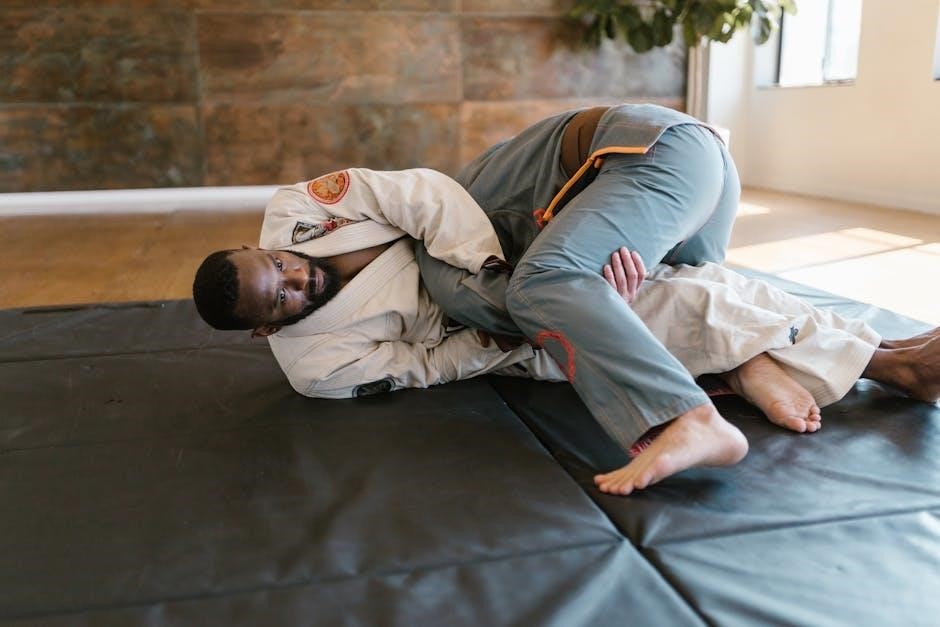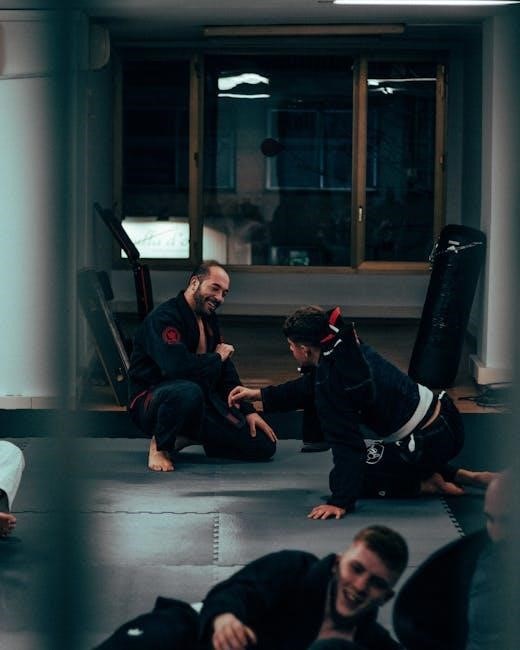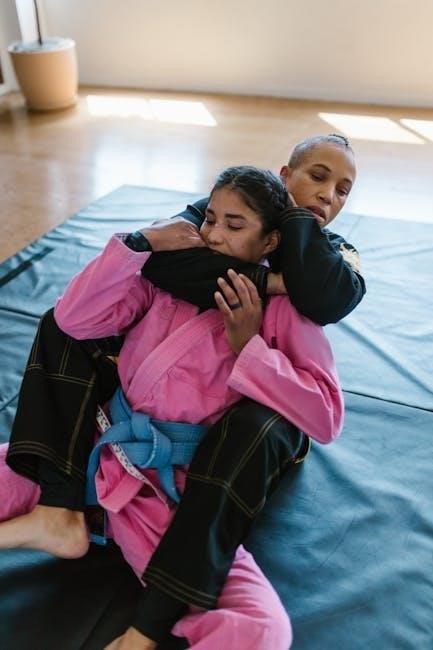This guide provides essential information on selecting the right BJJ belt size, ensuring proper fit, optimal performance, and compliance with martial arts standards.
1.1 Understanding the Importance of Proper Belt Fit
A proper BJJ belt fit is crucial for both functionality and performance. A belt that is too tight can restrict movement, while one that is too loose may unravel during training. Correct sizing ensures comfort, prevents distractions, and allows for effective technique execution. Measuring waist circumference accurately is key, as it directly impacts the belt’s fit and usability. Improper fit can lead to discomfort, safety issues, or even non-compliance with competition regulations. Therefore, understanding and achieving the right belt size is essential for optimal training and competition success in Brazilian Jiu-Jitsu.
1.2 Brief Overview of BJJ Belt Ranking System
The BJJ belt ranking system progresses from white to blue, purple, brown, black, and beyond. Each belt represents skill mastery and dedication. The system motivates practitioners to set goals and track progress. Belts are awarded based on technique proficiency, sparring performance, and time invested. Proper belt size ensures athletes can train effectively and safely, aligning with the system’s integrity and standards.

Key Factors in Determining BJJ Belt Size
Waist circumference, BJJ gi size, and belt length are crucial for determining the correct belt size, ensuring optimal fit and performance during training and competitions.
2.1 Measuring Waist Circumference
Accurately measuring waist circumference is essential for determining the correct BJJ belt size. Place the tape measure around the natural waistline, typically at hip level, ensuring it’s snug but not tight. The measurement should be taken without compressing the skin or clothing. Proper alignment ensures the belt sits comfortably and provides the necessary support during training. Consistency in measurement method helps maintain accuracy across different manufacturers and sizes. This step is foundational for selecting a belt that meets both performance and regulatory standards in Brazilian Jiu-Jitsu.
2.2 Considering BJJ Gi Size
BJJ Gi size plays a crucial role in determining the appropriate belt size. Belts are typically designed to coordinate with the Gi’s size, ensuring a consistent fit. Manufacturers often align belt sizes with Gi sizes, such as A1, A2, and A3, corresponding to different waist measurements. It is important to select a belt that matches your Gi size to maintain uniformity and ensure proper fit. This alignment helps in meeting both performance and aesthetic requirements during training and competitions. Always refer to the manufacturer’s sizing chart for accurate coordination between Gi and belt sizes.
2.3 Belt Length and Manufacturer Standards
Belt length and manufacturer standards are key factors in selecting the right BJJ belt. Most belts are designed to be approximately 2.5 meters long, allowing for proper wrapping and tying. Manufacturer sizing charts often include specific length guidelines, ensuring consistency across sizes. It’s important to consider that some belts may shrink slightly after washing, so choosing a length that accommodates this is crucial. Always check the manufacturer’s standards to ensure your belt meets both functional and regulatory requirements for training and competition.

How to Properly Measure for a BJJ Belt
Measure your natural waistline with a flexible tape measure, ensuring a snug fit. Wrap the belt around your waist, aligning the middle of the belt with your navel for accurate sizing.
3.1 Step-by-Step Measurement Guide
- Wrap a flexible tape measure around your natural waistline, keeping it snug but not tight.
- Position the tape measure at hip level, ensuring it’s parallel to the floor.
- Take note of the measurement in inches or centimeters.
- Compare your waist measurement to the manufacturer’s size chart to determine your belt size.
- Consider belt length by aligning the middle of the belt with your navel and ensuring the ends hang evenly when tied.
- Verify compliance with IBJJF standards, ensuring the belt is 4-5 cm wide and ends hang 20-30 cm when tied.
Accurate measurement ensures proper fit, comfort, and adherence to martial arts regulations.
Choosing the Right Belt Size
Selecting the correct BJJ belt size ensures optimal performance and compliance with martial arts standards. Proper fit enhances comfort and technique execution during training and competitions.
4.1 Understanding Manufacturer Size Charts
Manufacturer size charts are essential for selecting the correct BJJ belt size. Each brand may have slight variations in sizing, so it’s crucial to review their specific charts. Most charts correlate belt sizes with waist measurements, ensuring a proper fit. Some manufacturers also standardize sizes to align with BJJ gi sizes, making it easier to match your belt to your uniform. Always cross-reference your waist measurement with the manufacturer’s chart to avoid sizing errors. This step ensures comfort, optimal performance, and a belt that meets your training needs effectively.
By understanding how manufacturers structure their sizing, you can make informed decisions. If your waist size aligns with a larger belt size on the chart, it’s best to opt for that size to ensure the belt is not too tight or restrictive. Proper fit enhances both comfort and technique execution, making it a critical factor in your training journey. Always prioritize accuracy when using these charts to guarantee the best results for your BJJ practice.

4.2 Ensuring Compliance with IBJJF Regulations
When selecting a BJJ belt, it’s crucial to ensure it meets IBJJF regulations. The belt must be 4 to 5 cm wide, with ends hanging 20 to 30 cm when tied in a double knot. It should be made of cotton or a similar material and feature the correct color and stripe pattern for your rank. Higher belts may include additional stripes to denote seniority. Always verify these standards before purchasing, as non-compliant belts may disqualify you from competitions. Compliance ensures your belt is both functional and regulation-approved for training and events.

By adhering to IBJJF guidelines, you maintain the integrity of your training and competitions. Proper belt standards are essential for a professional and consistent appearance on the mat. Always check the material quality, color accuracy, and stripe details to avoid issues during tournaments. This attention to detail ensures your belt meets all necessary requirements, allowing you to focus on your performance without worrying about gear violations.
BJJ Belt Ranking System Overview
The BJJ belt system progresses from white to blue, purple, brown, and black, with stripes indicating seniority. Each rank requires time, skill, and dedication to achieve.
5.1 Belt Ranks and Their Requirements

Belt ranks in BJJ include white, blue, purple, brown, and black, each with specific requirements. White belts start as beginners, while blue indicates basic proficiency. Purple signifies intermediate skills, brown advanced, and black mastery. Time-in-grade and technical proficiency are key. Stripes on belts denote experience within a rank. Promotion criteria vary by school but typically include skill demonstrations and time training. Understanding these ranks helps practitioners track progress and set goals in their martial arts journey.

Common Mistakes to Avoid
Common mistakes include ignoring proper measurement techniques, not considering belt shrinkage, and overlooking manufacturer sizing charts, which can lead to ill-fitting belts and discomfort during training.
6.1 Incorrect Measurement Techniques

Incorrect measurement techniques are a common issue when determining BJJ belt size. Many individuals measure too loosely or too tightly, leading to an improper fit. Additionally, failing to measure at the correct hip level or not accounting for belt shrinkage can result in discomfort and performance issues. It’s crucial to follow a consistent method, such as wrapping the tape measure snugly around the natural waistline, to ensure accuracy. Neglecting these steps can lead to a belt that is either too tight or too loose, affecting both training and compliance with regulations.
6.2 Ignoring Manufacturer Sizing
Ignoring manufacturer sizing is a common mistake that can lead to an ill-fitting belt. Each manufacturer has its own sizing standards, and assuming a “one-size-fits-all” approach can result in a belt that is either too tight or too loose. Failing to consult the specific size chart provided by the manufacturer can cause discomfort during training and may lead to non-compliance with regulations. Always verify the measurements and guidelines set by the belt’s manufacturer to ensure the best fit and performance. Proper sizing is crucial for both functionality and adherence to martial arts standards.
6.3 Not Considering Belt Shrinkage
One common oversight is neglecting the natural shrinkage of BJJ belts, especially after washing. Belts are typically made of cotton, which can shrink by up to 3-5% when washed in hot water. Failing to account for this can result in a belt that becomes too tight or restrictive. To avoid this, consider purchasing a belt slightly longer than your measured size or checking the manufacturer’s guidelines for shrinkage. Proper care, such as washing in cold water, can also help maintain the belt’s original size and fit over time.

Care and Maintenance of BJJ Belts
Proper care ensures longevity. Wash belts in cold water with mild detergent, avoid harsh chemicals, and air-dry to prevent shrinkage and maintain quality.
7.1 Tips for Preserving Belt Quality
Regular washing with mild detergent in cold water helps maintain hygiene without damaging the fabric. Avoid using bleach or harsh chemicals, as they can degrade the material. Air-drying is recommended to prevent shrinkage and cracking. Storing belts in a cool, dry place away from direct sunlight preserves color vibrancy. Additionally, minimizing exposure to extreme heat prevents wear and tear. Following these care tips ensures your belt remains durable and retains its quality over time.

Selecting the right BJJ belt size ensures proper fit, performance, and compliance with IBJJF standards. Proper care and maintenance extend its lifespan, supporting your martial arts journey.
